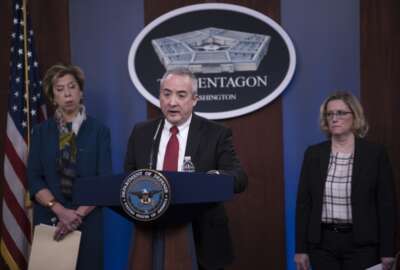

The pandemic has shown federal and industry leaders in the intelligence community: the nature of classified work may be ripe for change.
With many civilian agencies now considering how they’ll reopen and modify office spaces, the pandemic has shown federal and industry leaders in the intelligence community that work arrangements for the classified workforce can — and likely will — need to change too.
“When we get back to normal, there is not going to be the normal we knew of pre-Covid,” Bill Evanina, director of the National Counterintelligence and Security Center at the Office of the Director of National Intelligence, said last week on a Intelligence and National Security Alliance (INSA) webinar. “We’ve been able to identify the fact that we are just as successful, with some exceptions, with people working at home than we were before.”
Before the pandemic, telework arrangements in the intelligence community weren’t common.
Just one person at ODNI was eligible to work remotely in fiscal 2018, according to the latest telework report from the Office of Personnel Management.
The CIA had 93 employees telework at some point in 2018. At the FBI, 54 employees spent at least one day out of the year working from home.
Evanina said he’d look to industry for suggestions and models on how the federal classified workforce could more fully embrace telework in the future. Having more flexible work arrangements — regardless of a pandemic or national emergency — will be key to attract young, fresh talent to join the IC, he added.
“We’re at a precipice right now to immediately find solutions on teleworking,” he said. “We’ve identified some pros and cons to having employees work at home. We’re still working through the contractor aspect of that and how does that look and feel in the future.”
Chris Bellios, the chief operating officer for Hexagon US Federal, is part of a new INSA working group that’s reviewing how the intelligence community might safely continue classified work and also open up more remote options.
He said his own employees who support IC agencies have experienced a wide variety of work arrangements during the pandemic.
Some agencies provided their contractors with government-furnished equipment and allowed them to move unclassified elements of their work to a remote site, he said.
But others moved their employees and contractors into rotating shifts, where some worked from 6 a.m. to 2 p.m., and new group came into the classified office space to work from 3 to 11 p.m., Bellios said. Agencies took the hour in between the two shifts to clean the space, he added.
Other agencies have brought employees and contractors into the workplace for one week and brought a second group in during the next.
Bellios said the variety in the way intelligence agencies have handled remote and classified work is due, in part, to ODNI’s April guidance, which simply encouraged them to make use of the remote work flexibilities for contractors they received under the Coronavirus Aid, Relief and Economic Security (CARES) Act.
“It was still permissive,” he said of the ODNI guidance. “It wasn’t mandated, so each agency had to digest it and then work a process along the way. That did create a little challenge at first, because there are 16 different ways to approach how to implement it. Some agencies were better than others and jumped right into a process to easily and quickly transition to a remote environment.”
Industry groups like INSA had raised the alarm bells about the pandemic and its potential impacts on the classified workforce, which generally must perform top-secret work from secure spaces, back in March.
Now well into the pandemic, Evanina acknowledged there’s room to reimagine when and how employees and contractors who were previously considered “classified workers” handle their tasks.
“Just because you work in the IC and just because you have a top-secret clearance, does that mean that everything you do is classified?” he said. “Just because you have a top-secret clearance doesn’t mean you can’t work at home to do a percentage of your job. I will caveat that, though. As we move aggressively toward what that might look like, we have to find effective solutions to protect that work, protect that employee and protect our communications from the adversaries, who are actually actively watching how we do this right now.”
For Bellios, he hopes the restrictions that come with working during a pandemic may force agencies to reassess what’s considered “classified” and what isn’t.
“The federal government is notorious for over-classifying information,” he said. “The lower the classification, the more the people can see it. You want as many federal entities that don’t maintain clearances to be aware of the data. There’s always the balance between that and security, but to the degree where we could evaluate the over-classification of documents, that’s where there’s a shift. There was always a desire to do that but not much progress.”
Few policy updates take hold quickly within the intelligence community, but industry leaders are considering how, perhaps, they can make changes to the workplace on their own.
Bellios’ own company has a workforce readiness task force that’s reevaluating its leased space, how many employees need to physically return to the office and the productivity of his remote employees.
“Probably 20 years ago the fad of remote working started to take shape in the D.C. area. It had a quick uptick, and then it leveled off. It almost started to reverse. This is going to regenerate that. You’re going to start to see people working from everywhere, not just northern Virginia,” he said. “It gives your future workforce more options.”
Copyright © 2024 Federal News Network. All rights reserved. This website is not intended for users located within the European Economic Area.
Nicole Ogrysko is a reporter for Federal News Network focusing on the federal workforce and federal pay and benefits.
Follow @nogryskoWFED


